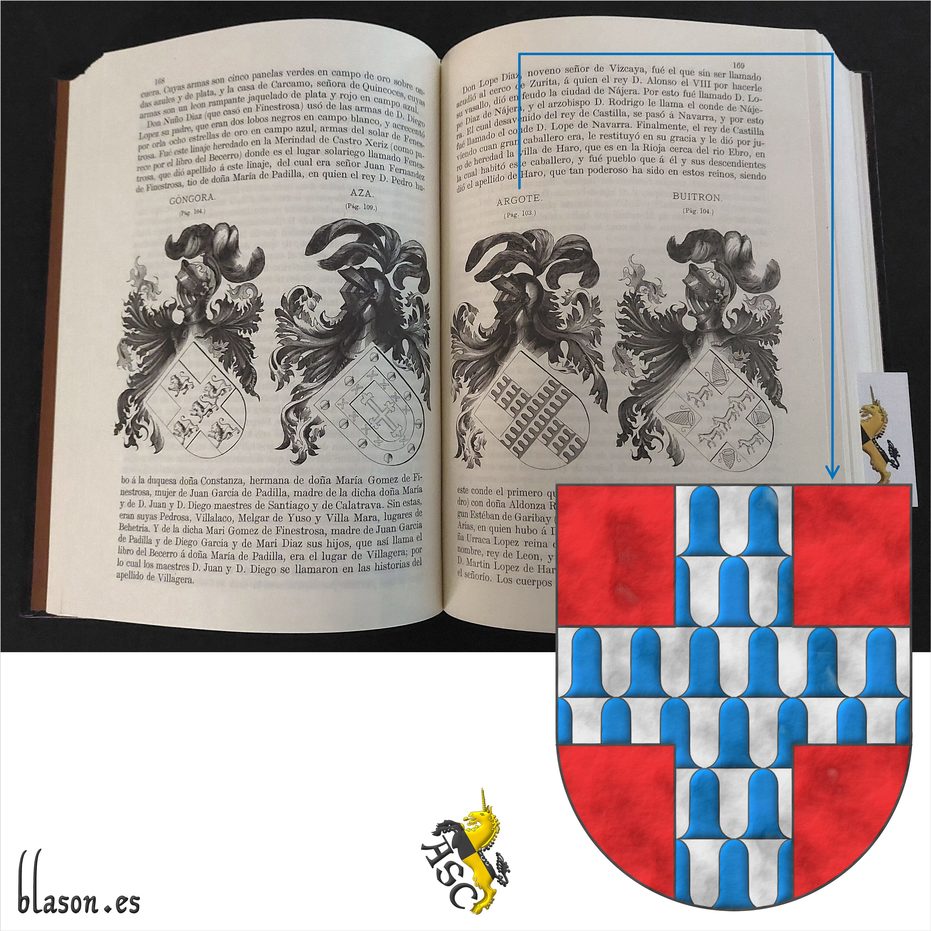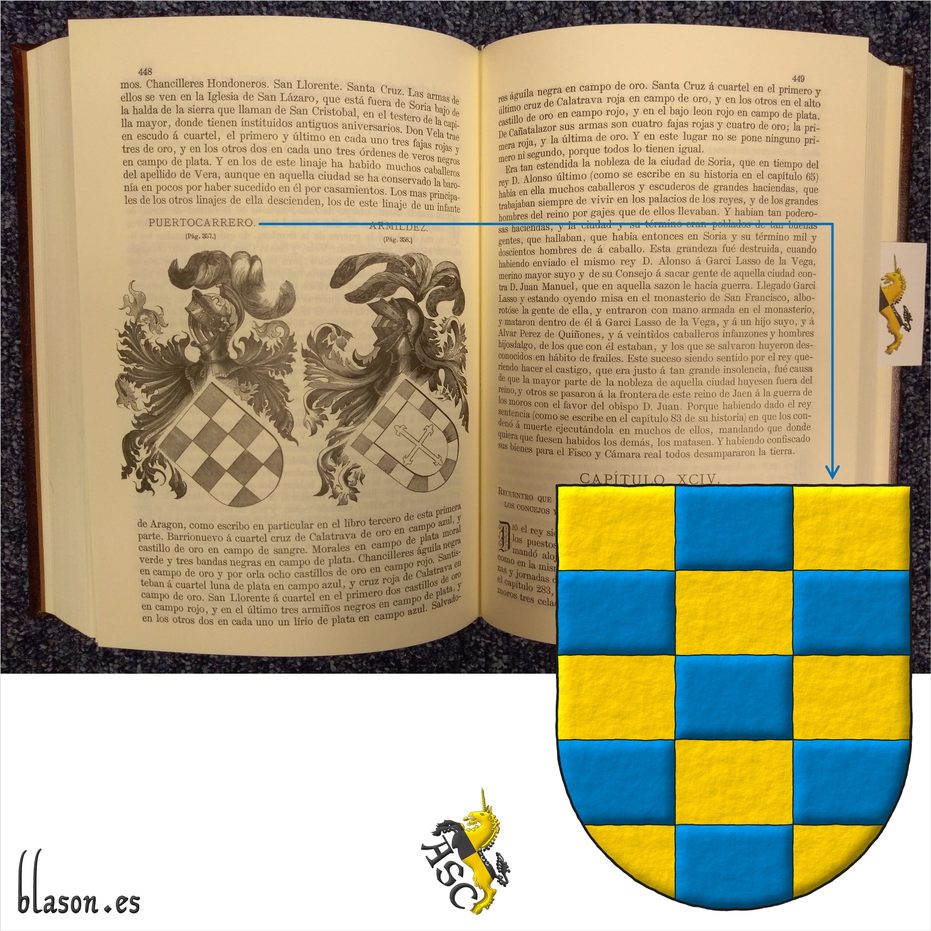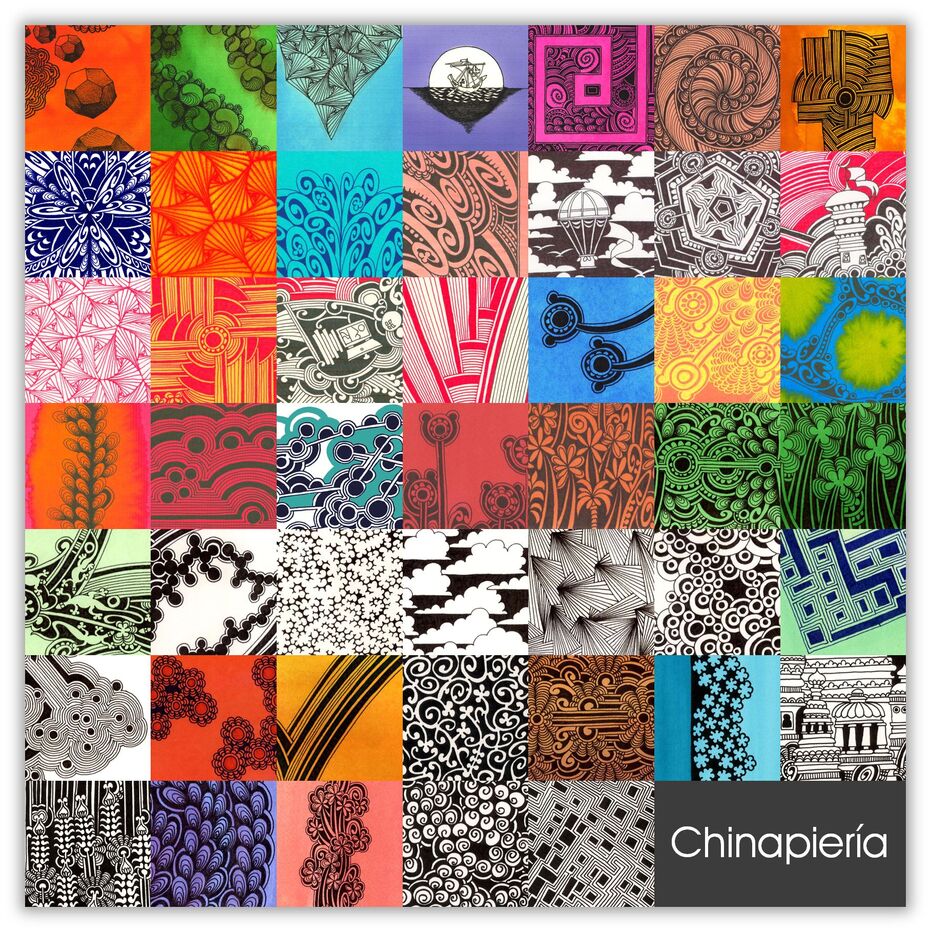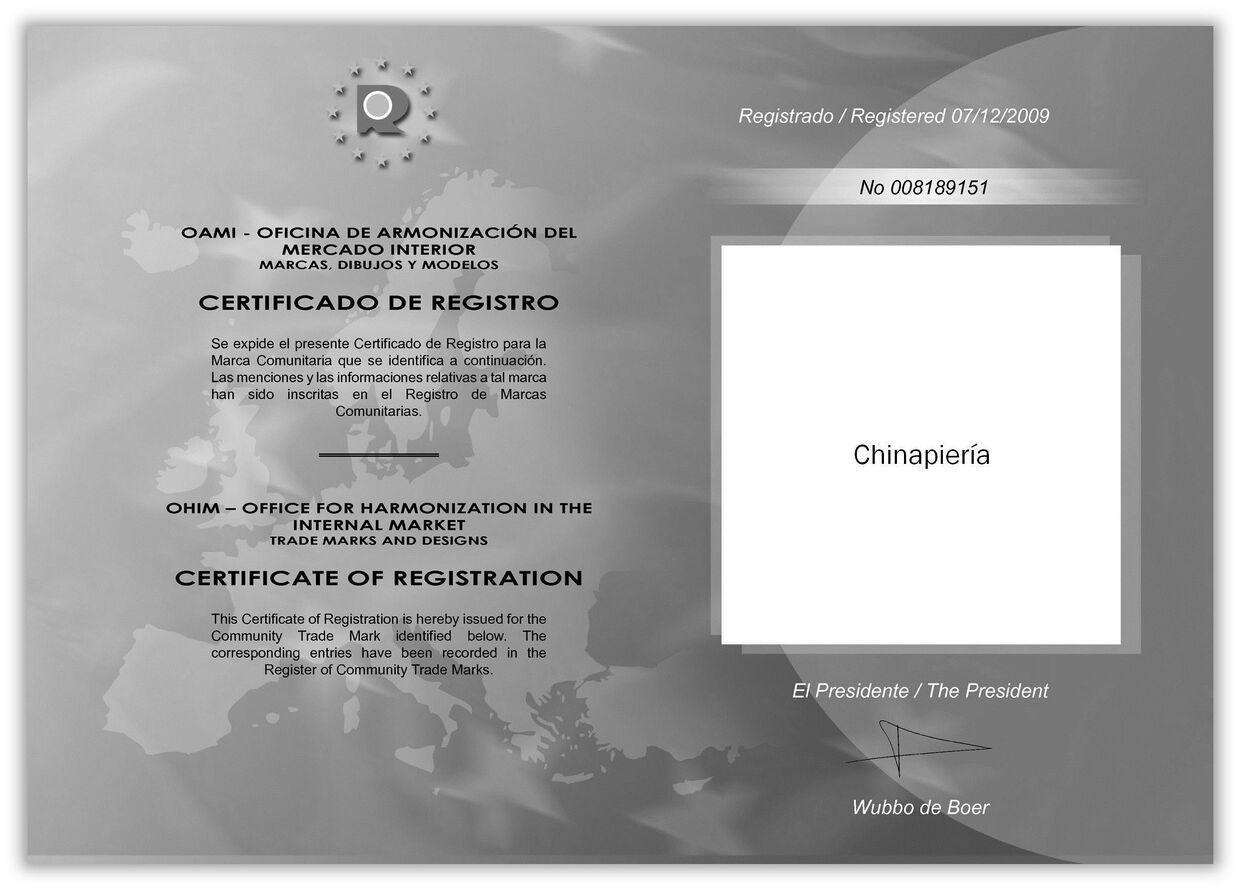
Berenguela of Castile and Alfonso IX
[ Argent, a lion rampant Purpure, armed and langued Gules ] accolé with [ Gules, a castle triple towered Or, port and windows Azure, masoned Sable ].
[ Escudo de plata, un león rampante de púrpura, armado y lampasado de gules ] acolado de un [ escudo de gules, un castillo de oro, aclarado de azur, mazonado de sable ].
Arms of the King of Leon and Queen of Castile, as interpreted by me with: the two shields shaped with rounded arches; the fields of both coat of arms, the lion, and the castle illuminated; and the whole composition featuring a watercolor finish.
Representation of the coats of arms of Alfonso IX of León and Berenguela of Castile as accolé arms ~ «escudos acolados». King Ferdinand III created his coat of arms, based on the coats of arms of his parents, through the marshalling of their arms ~ «composición de sus armas». For this purpose, the saintly king invented a type of composition, which later became widely used, known as quarterly ~ «cuartelado». Other ways to combine the coats of arms of two spouses are:
- Creating a new dimidiated shield ~ «dimidiado».
- Creating a new impaled shield ~ «partido».
- Adding one coat of arms to another as an escutcheon of pretence ~ «escusón de pretensión», in this case, rather than a claim, there was full ownership.
Blazon keywords: Without divisions, Argent, Purpure, Gules, One, Lion, Rampant, Armed, Langued, Or, Azure, Sable, Castle, Port and windows and Masoned.
Style keywords: Semi-circular, Outlined in sable, Tilted shield and Watercolor.
Classification: Interpreted, Personal, Accolé arms, Kingdom of Castile and Kingdom of León.
Bearer: Berenguela of Castile.


Alfonso VIII of Castile
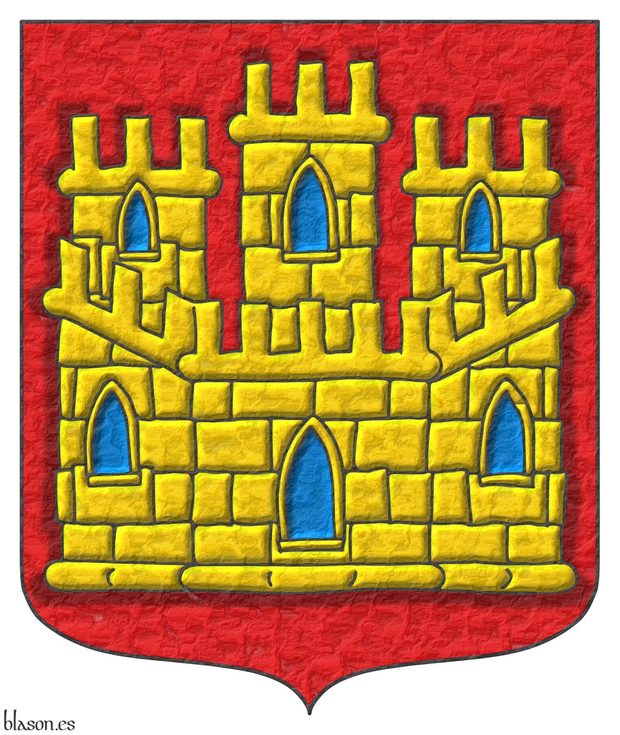
Born on November 11, 1155, in Soria and died on October 6, 1214, in Gutierre-Muñoz, Avila.
Gules, a castle triple towered Or, port and windows Azure, masoned Sable.
Escudo de gules, un castillo de oro, aclarado de azur, mazonado de sable.
Existing arms interpreted by me as follows: the shield’s shape is pointed and rounded; the field has been enameled Gules; the castle is outlined, illuminated, and shaded; the whole composition features a heavily hammered metal finish.
This ancient coat of arms of Castile can be consulted, among other sources, in [Argote de Molina, G.; 1588; chapter XLII].
Blazon keywords: Without divisions, Gules, Or, Azure, Sable, One, Castle, Port and windows and Masoned.
Style keywords: Ogee, Illuminated, Shaded, Outlined in sable and Hard metal.
Classification: Interpreted, Personal, Coat of arms and Kingdom of Castile.
Bearer: Alfonso VIII of Castile.


Alfonso VIII of Castile, royal crown
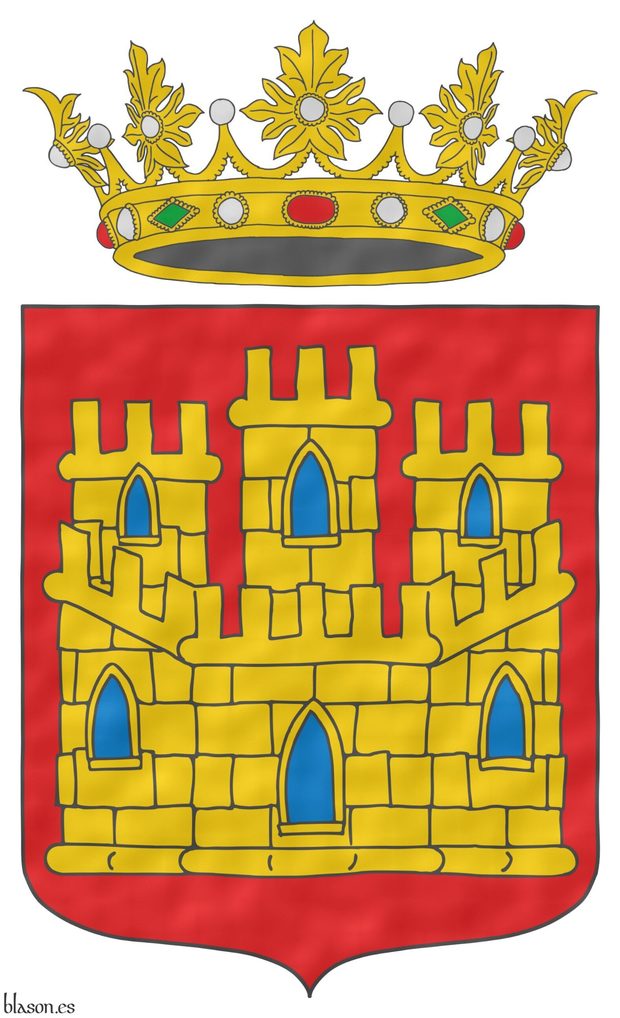
King of Castile from 1158 to 1214.
Gules, a castle triple towered Or, port and windows Azure, masoned Sable. Crest: An open royal crown Or.
Escudo de gules, un castillo de oro, aclarado de azur, mazonado de sable. Timbrado de una corona real abierta.
Arms of the king, as interpreted by me, as follows: the shield's shape is pointed and rounded; the field is enameled Gules; the castle is outlined in Sable; and the whole composition features a watercolor finish.
In [Valero de Bernabé, L.; 2009a; page 1] the author specifies the main characteristics of the «Castilian royal castle», which can be summarized as: «with three towers, the middle one taller, and the two flanking it identical», «each tower crowned with three battlements», «one to three doors and one or two pointed windows on each tower», and «masoned and battlemented», as also noted by the same author in [Valero de Bernabé, L.; 2009b; page 33].
Blazon keywords: Without divisions, Gules, Or, Azure, Sable, One, Castle, Port and windows, Masoned, Crest, Open royal crown and Crown.
Style keywords: Ogee, Plain tincture, Outlined in sable and Watercolor.
Classification: Interpreted, Personal, Coat of arms and Kingdom of Castile.
Bearer: Alfonso VIII of Castile.


![Ver [Argote de Molina, G.; 1588] en referencias bibliográficas. Libro abierto, hojas de plata, filo de oro, guardas de gules, tapas de sable.](../css/Libro.Bibliografia.png)
Argote de Molina, G.; 1588
Gonzalo Argote de Molina, «Nobleza de Andalucía», dedicated to King Philip II of Spain, with about 500 coat of arms engraved, printed by Fernando Díaz, Seville, 1588.
There are other editions, for example, the edition by Francisco López Vizcaíno, 799 pages, Jaen, 1867, or facsimile edition by Riquelme y Vargas Ediciones SL, Jaén, 1991, my copy is the number 1268.
Bibliographical reference of century XVI.
Classification: De bibliotheca, Castilian language and In black and white.
Author: Argote de Molina, Gonzalo.
Bibliographic reference mentioned in the following articles:
- Alfonso IX of Leon
- Alfonso VIII of Castile
- Argote de Molina, Gonzalo
- James I of Aragon
- Álvaro de Zúñiga y Guzmán
External links:
- Virtual Library of Andalusia, 1867.
- Digital Library Madrid's memory, 1588 edition from page 6 missing cover and initial pages.
- National Library of Spain, bibliographic record, there are 2 copies of the edición of 1588.
- National Library of Spain, edition of 1588, cover of the first copy.
- National Library of Spain, edition of 1588, cover of the second copy, this has more resolution than the previous copy.
- Google Books, the second book and not complete.
Internal resources: ArgoteMolinaG1588.22.NoblezaAndalucia.Madrid.pdf is the edition of the year 1588 in PDF digital format, ArgoteMolinaG1588.23.Bne.Baja.resolucion.R10805.pdf is the edition of the year 1588 in PDF digital format and low resolution, ArgoteMolinaG1588.24.Bne.Alta.resolucion.R26842.pdf is the edition of the year 1588 in PDF digital format and hight resolution, ArgoteMolinaG1588.25.NoblezaAndalucia.1867.pdf is the edition of the year 1866 in PDF digital format for Adobe Reader only and a facsimile edition as a physical book on paper.


![Ver [Emblemata; 2000] en referencias bibliográficas. Libro abierto, hojas de plata, filo de oro, guardas de gules, tapas de sable.](../css/Libro.Bibliografia.png)
Emblemata; 2000
Baron of Valdeolivos Emblematic Chair, of the Fernando el Catolico Institution, of the Centre of Scientific Research (C. S. I. C.) and of the Government of Zaragoza, «Emblemata», Volume 6th, Emblemata Aragonese Magazine about Emblems (E. R. A. E.), 419 pages, 124 pictures, ISSN 1137-1056, Legal deposit Z.3.937 1996, printed by the Cooperativa de Artes Gráficas Librería General, Zaragoza, 2000.
Bibliographical reference of century XX.
Classification: Magazine and Castilian language.
Author: Cátedra de Emblemática Barón de Valdeolivos.
External resources:
Internal resources: Emblemata2000.Volumen06.pdf.


Salmerón Cabañas, A.; 2009
Antonio Salmerón Cabañas, «Chinapieria», trademark registered in the Office for Harmonisation in the Internal Market (OHIM) of the European Union, with presentation number 008189151 and registration date on 7th of December of 2009.
The trademark «Chinapieria» refers to a special type of pen drawing, usually done automatically, with the mind in a special state of abstraction, formed by various types of volutes, traces in the form of leaves, stems and very stylized flowers, growths that emulate fractal behaviors, random tours, etc. as they are shown in the image that this article illustrates.
El term «chinapieria» is a creation of my mother, Henar Cabañas Martín.
The first time I searched for this term on the internet, long before registering it, I was surprised that there was not a single occurrence.
Bibliographical reference of century XXI.
The author is Salmerón Cabañas, Antonio.
The following article cites this bibliographic reference:
Category: Intellectual property.


![Ver [Valero de Bernabé, L.; 2009b] en referencias bibliográficas. Libro abierto, hojas de plata, filo de oro, guardas de gules, tapas de sable.](../css/Libro.Bibliografia.png)
Valero de Bernabé, L.; 2009b
Luis Valero de Bernabé y Martín de Eugenio, «Los Castillos en la Heráldica», Magazine of the Real Asociación de Hidalgos de España, «La Gacetilla de Hidalgos de España», number 524, pages 32, 33 and 34. Madrid, October, November and December 2009.
Bibliographical reference of century XXI.
Author: Valero de Bernabé y Martín de Eugenio, Luis.
Bibliographic reference mentioned in the following articles:
- Alfonso VIII of Castile, royal crown
- Edward IV of England; 1461
- Royal Association of Hidalgos of Spain
- Valero de Bernabé, L.; 2009a
External link:
Internal resources: ValeroBernabeL2009.520.RevistaCompleta.pdf.


![Ver [Vivar del Riego, J. A.; 2007] en referencias bibliográficas. Libro abierto, hojas de plata, filo de oro, guardas de gules, tapas de sable.](../css/Libro.Bibliografia.png)
Vivar del Riego, J. A.; 2007
José Antonio Vivar del Riego, Diplomado en Genealogía Heráldica y Nobiliaria, «El Blasón Escrito: La Historia de los Libros de Heráldica», lecture, 31st of May of 2007.
Bibliographical reference of century XXI.
The author is Vivar del Riego, José Antonio.
External resource:
Internal resources: VivarDelRiegoJA2007.HistoriaLibrosHeraldica.pdf.

Continue with: Leonor Plantagenet.
-
Language
-
Categories of heraldry
-
Divisions of the field
- Without divisions
- Party per pale
- Party per fess
- Party per bend
- Party per bend sinister
- Tierce
- Tierce sinister
- Tierced per pale
- Tierced per fess
- Tierced per bend
- Tierced pallwise inverted
- Quarterly
- Quarterly per saltire
- Gyronny
- Party per fess, the chief per pale
- Party per pale, the sinister per fess
- Party per fess, the base per pale
- Party per pale, the dexter per fess
- Chapé
- Chaussé
- Embrassé
- Contre-embrassé
- Party per chevron
- Enté
- Enté en point
- Flanched
-
Metals
-
Colours
-
Furs
-
Other tinctures
-
Ordinaries and sub-ordinaries
-
Diminutives of the ordinaries
-
Other charges
-
Charges from Nature
Water, Eagle, Bald eagle, Eagle claw, Dorsal fin, Tail fin, Two hands clasped, Lark, Tree, Trunk, Rainbow, Atom, Barbel, Acorn, Bighorn sheep, Arm, Owl, Vulture, Horse, Head, Goat, Camellia, Thistle, Merino ram, Kapok tree, Stag, Doe, Crescent, Increscent, Chrysanthemum, Tail, Tail addorsed, Ermine spot, Hummingbird, Snowflake, Heart, Roe deer, Neck, Stags' attires, Roe deers' attires, Raven, Dolphin, Diamond, Tooth, Elephant, Trunk (elephant), Beetle, Emerald, Starling, Mullet, Mullet of four points, Star of David, Estoile, Male figure, Fleur de lis, Flower, Cornflower, Dogwood flower, Lotus flower, Hop cone, Bluebonnet, Puffin, Ash, Rooster, Claw, Talon, Goose, Heron, Seagull, Pomegranate, Sunflower, Swallow-tail, Falcon, Leaf, Boar, Goldfinch, Laurel, Barn owl, Lion, Lioness, Lion passant, Leopard, Lion rampant guardant, Lynx, Lily, Madonna lily, Flame, Wolf, She-wolf, Parrot, Moon, Hand, Apple, Apple tree, Sea, Martlet, Wing, Two wings in vol, Covert, Blackbird, Mount, Trimount, Fly, Wrist, Elm, Olive tree, Orbital, Bear, Palm frond, Palm tree, Dove, Poplar leaf, Panther, Jaguar, Vine, Paw, Forepaw, Foot (palmiped), Foreleg, Peacock, Chest, Pelican, Pelican in her piety, Dog, Brach hound, Warren hound, Fish, Hoof, Beak, Feather, Ostrich feather, Cinquefoil, Quetzal, Branch, Sprig, Frog, Shamrock, Caboshed, Oak, Holm oak, Rose, Double rose, Savage, Serpent, Plough of Ursa Major, Sun, Sun in splendour, Ray of the sun, Lightning flash, River, Stem, Badger, Tyger, Linden, Wheat, Wheat spike, Bull, Tulip, Udder, Escallop and Fox.
-
Artificial charges
Halberd, Plough share, Ace of spades, Anchor, Cyclamor, Torch, Bow, Arch, Harp, Non-classic artifact, Winnowing fan, Crozier, Conductor's baton, Pair of scales, Ship, Oar, Sail, Norman ship, Beret, Grenade, Ecclesiastical cap, Arm vambraced, Knight, Chain, Cup, Covered cup, Monstrance, Bell, Bell tower, Cannon, Cannon dismounted, Cannon port, Carbuncle, Castle, Ribbon, Clarion, Nail, Crucible, Cord, Dagger, Key ward, Turret, With a turret, Armillary sphere, Sword, Federschwert, Sabre, Parchment, Scroll, Skirt, Arrow, Club, Garb, Sheaf of tobacco, Scythe, Gauntlet, Axe, Buckle, Galician granary, Host, Bonfire, Polish winged hussar, Church, Fanon, Oil lamp, Spear, Spear's head, Fleam, Letter, Book, Open book, Closed book, Bookmark, Page, Line, Lantern, Key, Four crescents joined millsailwise, Hammer, Two-handed sword, Menorah, Mortar, Pestle, Number, Knot, Celtic Trinity knot, Water-bouget, Comb, Piano, Millstone, Millrind, Millwheel, Quill, Clay pot, Potent, Bridge, Cuffed, Hourglass, Chess rooks, Compass rose, Rosette of acanthus leaves, Mullet of six points pierced, Broken, Portcullis, Wheel, Wagon-wheel, Symbol, Sackbut, Drum, Loincloth, Geometric solid, Tetrahedron, Tower, Trident, Trumpet, Double vajra and Anvil.
-
Immaterial charges
Angel, Archangel, Basilisk, Heart enflamed, Sacred Heart of Jesus, Paschal lamb, Dragon's head, Dragon, Wyvern, Phoenix, Garuda, Griffin, Sea-griffin, Winged hand, Our Lady of Mercy, Pegasus, Saint George, Mermaid, Trinity, Triton, Golden fleece, Unicorn and Ouroboros.
-
External elements
-
Heraldic creations
-
References
-
Formats
-
Keywords on this page
Port and windows, Watercolor, Alfonso VIII of Castile, Armed, Azure, Berenguela of Castile, Bibliography, House of Plantagenet, Castle, Crest, Ogee, Crown, Open royal crown, De bibliotheca, Outlined in sable, In black and white, In pale, Coat of arms, Accolé arms, Personal, Gules, Illuminated, Interpreted, Langued, Castilian language, Leonor Plantagenet, Leopard, Lion, Lineage, Masoned, Semi-circular, Hard metal, Or, Argent, Without divisions, Intellectual property, Purpure, Rampant, Kingdom of Castile, Kingdom of England, Kingdom of León, Magazine, Tilted shield, Sable, Century XVI, Century XX, Century XXI, Shaded and One.
![Berenguela of Castile and Alfonso IX [ Argent, a lion rampant Purpure, armed and langued Gules ] accolé with [ Gules, a castle triple towered Or, port and windows Azure, masoned Sable ].](../escudo_armas/BerenguelaC.23.Matrimonio.jpg)
